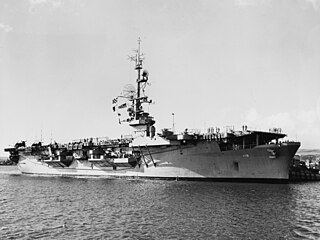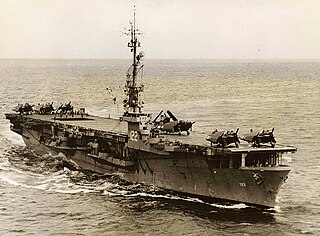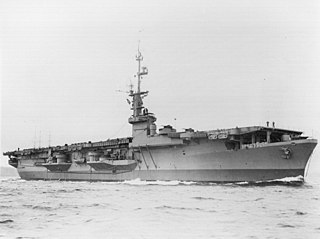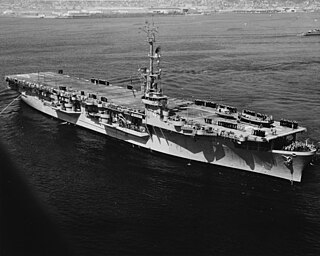
USS Badoeng Strait (CVE-116) was a Commencement Bay-class escort carrier of the United States Navy during the Korean War.

USS Bairoko (CVE-115) was a Commencement Bay-class escort carrier of the United States Navy in service from 1945 to 1955.

USS Rabaul (CVE/CVHE/AKV-21) was a Commencement Bay-class escort carrier of the United States Navy. She was delivered on 30 August 1946, but never commissioned. After spending 26 years in reserve, she was scrapped in 1973.

USS Palau (CVE–122) was a Commencement Bay-class escort carrier of the United States Navy.

USS Tinian (CVE-123) was a Commencement Bay-class escort carrier of the United States Navy. Ordered and constructed during World War II, Tinian never entered active service and was assigned to the Pacific Reserve Fleet, Tacoma after being completed. In June 1955, the ship was reclassified a helicopter carrier and in May 1959, a cargo ship and aircraft ferry. The ship remained in reserve for her entire career and was struck from the Naval Vessel Register on 1 June 1970 and sold for scrap.

USS Mindoro was a Commencement Bay-class escort carrier of the United States Navy. The ship was a converted oil tanker, and she had a capacity to carry up to thirty-three aircraft. She was built during World War II, but was completed too late to see action during the conflict. She nevertheless saw service with the 8th Fleet in the late 1940s and early 1950s in the Atlantic Ocean. She also made two deployments to the Mediterranean Sea, in 1950 and 1954, before being decommissioned in January 1955 and assigned to the Atlantic Reserve Fleet. She was retained for just four years before being struck from the naval register in December 1959 and thereafter scrapped.

USS Point Cruz (CVE-119) was a Commencement Bay-class escort carrier of the United States Navy. Originally named Trocadero Bay until 5 June 1944 when it was renamed after the Honiara suburb Point Cruz, which was an important location during the Guadalcanal Campaign. She was laid down on 4 December 1944 by Todd Pacific Shipyards Incorporated, Tacoma, Washington; launched on 18 May 1945, sponsored by Mrs. Earl R. DeLong; and commissioned on 16 October 1945.

USS Saidor (CVE-117) was a Commencement Bay-class escort carrier of the United States Navy.

USS Commencement Bay (CVE-105), the lead ship of her class, was an escort carrier and later helicopter carrier of the United States Navy, used mostly as a training ship.

USS Cape Gloucester (CVE-109) was a Commencement Bay-class escort carrier of the United States Navy, in service from 5 March 1945 to 5 November 1946. After spending another 25 years in the reserve fleet, the ship was scrapped in 1971.

USS Block Island (CVE-106) was a Commencement Bay-class escort carrier of the United States Navy. She was the second ship to carry her name, done in honor of the first one, being launched 12 days after the original was sunk.

USS Gilbert Islands (CVE-107) was a Commencement Bay-class escort carrier of the United States Navy.

USS Vermillion Bay (CVE-108) was a Commencement Bay-class escort carrier of the United States Navy. She was renamed Kula Gulf on 6 November 1943; laid down by Todd-Pacific Shipyards, Inc., Tacoma, Wash. on 16 December 1943; launched on 15 August 1944; sponsored by Miss Dorothy Mott; completed by Willamette Iron & Steel Corp., Portland, Oregon; and commissioned at Portland on 12 May 1945, Captain J. W. King in command.

USS Salerno Bay (CVE-110) was a Commencement Bay-class escort carrier laid down on 7 February 1944 by Seattle-Tacoma Shipbuilding Corporation, Tacoma, Washington; launched on 26 September 1944; sponsored by Mrs. Ward Gilbert; transferred to the Commercial Iron Works, Portland, Oregon, for completion on 29 September 1944; and commissioned on 19 May 1945, Captain W. C. Holt in command.

USS Siboney (CVE-112/AKV-12) was a Commencement Bay-class escort carrier of the United States Navy. She was the second ship named for Siboney, Cuba, the Cuban Village near which troops of Theodore Roosevelt's Rough Riders fought during the Spanish–American War.

USS Rendova (CVE-114) was a Commencement Bay-class escort carrier of the United States Navy.

USS Puget Sound (CVE–113) was a Commencement Bay-class escort carrier of the United States Navy.

USS Vella Gulf (CVE-111) was a Commencement Bay-class escort carrier of the United States Navy. She was laid down as Totem Bay on 7 March 1944 at Tacoma, Washington by the Todd-Pacific Shipyards. She was renamed Vella Gulf on 26 April 1944 and launched on 19 October 1944, sponsored by Mrs. Donald F. Smith. On 9 April 1945, she was commissioned with Captain Robert W. Morse in command.

USS Windham Bay (CVE-92) was the thirty-eighth of fifty Casablanca-class escort carriers built for the United States Navy during World War II. She was named after Windham Bay, within Tongass National Forest, of the Territory of Alaska. The ship was launched in March 1944, commissioned in May, and served as a replenishment and transport carrier throughout the Invasion of Iwo Jima and the Battle of Okinawa. Postwar, she participated in Operation Magic Carpet, repatriating U.S. servicemen from throughout the Pacific. She was decommissioned in August 1946, when she was mothballed in the Pacific Reserve Fleet. With the outbreak of the Korean War, however, she was called back to service, continuing to serve as a transport and utility carrier until 1959, when she was once again decommissioned. Ultimately, she was broken up in February 1961.

USS Mission Bay (CVE-59) was a Casablanca-class escort carrier of the United States Navy. She was named after Mission Bay, located northwest of San Diego. Launched in May 1943, and commissioned in September, she served as a transport carrier, ferrying aircraft to bases in Europe, Africa, and Asia. She also participated in the Battle of the Atlantic, protecting convoys and conducting antisubmarine patrols. Notably, she escorted President Roosevelt on-board the cruiser Quincy as he returned from the Yalta Conference. She was decommissioned in February 1947, when she was mothballed in the Atlantic Reserve Fleet. Ultimately, she was sold for scrapping in April 1959.






















